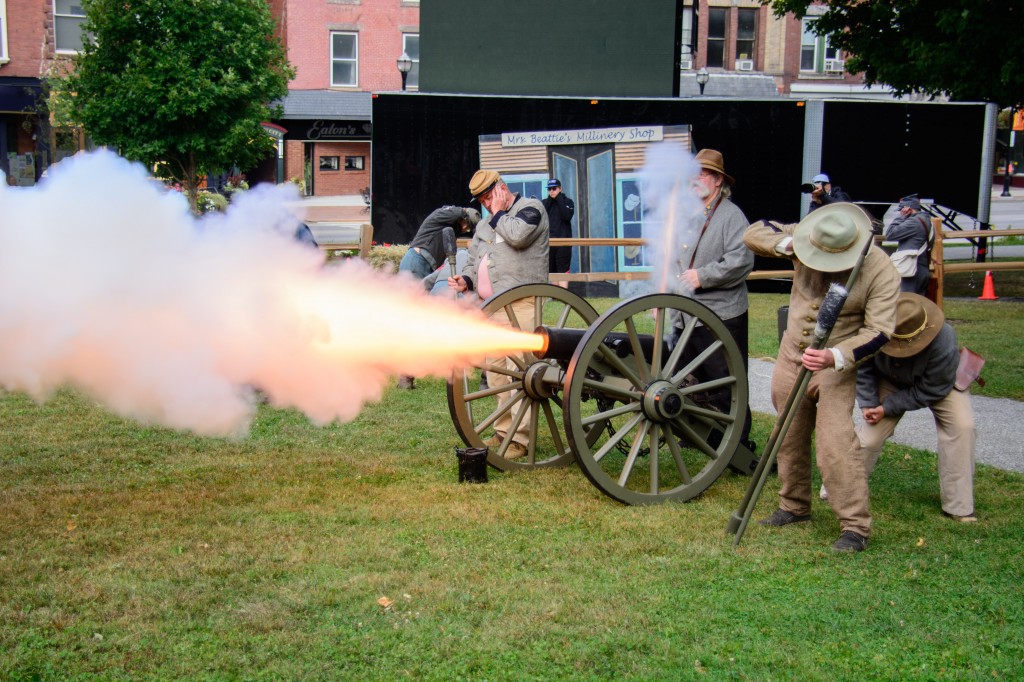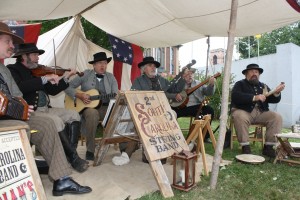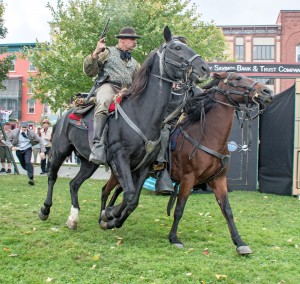 ST. ALBANS — Thousands of people gathered in Taylor Park this weekend to watch as Confederate raiders robbed banks, shot bystanders, and wreaked havoc on St. Albans.
ST. ALBANS — Thousands of people gathered in Taylor Park this weekend to watch as Confederate raiders robbed banks, shot bystanders, and wreaked havoc on St. Albans.
The commemoration of the 150th anniversary of the St. Albans Raid drew an estimated 8,500 to 10,000 people, according to the event co-chair, Admiral Warren Hamm. “It’s what we had hoped for,” he said this morning.
“The place has come alive,” he said of St. Albans, adding of the commemoration, “I think it’s going to be a catalyst to keep the spirit alive.”
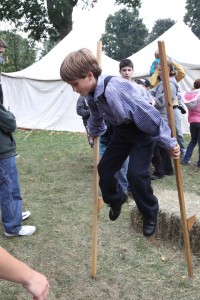 Prior to the 2 p.m. re-enactment of the raid on Saturday visitors gathered to listen to period music and speak with re-enactors. Children were able to take part in drills and engage in the same games as children 150 years earlier.
Prior to the 2 p.m. re-enactment of the raid on Saturday visitors gathered to listen to period music and speak with re-enactors. Children were able to take part in drills and engage in the same games as children 150 years earlier.
Steve Smith, of St. Albans, who organized all of the military re-enactors for the weekend – about 100 camped in Taylor Park – said he had heard great things from those attending, many saying it was the most impressive small town event they had ever attended.
Among the civilian visitors was Fred Purkey, of Montreal, and his children, who learned about doing laundry with washboards and that recent invention, the ringer, from Liz Hallett, a laundress re-enactor with the Union Army hailing from Massachusetts. “It’s fun doing it once, but I’m not sure I’d like to do it all the time,” said Natalia, aged 11.
Although he’s visited Vermont many times, Purkey said he had never before been downtown. “I didn’t even know there was this nice little downtown,” he said.
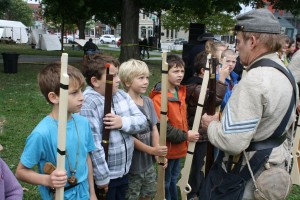 The Purkey children also learned how Union troops stored their rifles from the soldiers of the 2nd Vermont stationed in the park. The soldiers, who marched in file, would stack their arms together into a pyramid shape and hang their equipment from it at then end of the day’s march, explained Johnathon Croft. The order in which the rifles were stacked also was the order in which they marched. “If the need arises and you have to move fast, you grab it and go,” said Croft.
The Purkey children also learned how Union troops stored their rifles from the soldiers of the 2nd Vermont stationed in the park. The soldiers, who marched in file, would stack their arms together into a pyramid shape and hang their equipment from it at then end of the day’s march, explained Johnathon Croft. The order in which the rifles were stacked also was the order in which they marched. “If the need arises and you have to move fast, you grab it and go,” said Croft.
Stacking the rifles also meant the soldiers did not have to carry an 11-pound rifle with them through the camp.
The medical tent was a different story. There his children were “creeped out,” said Purkey.
It was an understandable reaction. Catrina MacKenzie of Montreal, an adjunct professor at both McGill University and UVM, explained how following an amputation, bones would have to be filed down and the skin folded over to create a place for the later attachment of a prosthetic.
Anesthesia was available in the form of ether and chloroform, but no antibiotics, making infection a serious risk, she explained.
Amelia Wallace, 7, of St. Albans listened closely to MacKenzie, taking notes for a report she would need to write later.
Visitors gathered more than 50 people deep to listen to performances by the 2nd South Carolina String Band which also performed for the Mayor’s Ball Saturday evening.
Mike Samwell of Kingston, Ontario, was asked to blow his horn as part of the string band’s playing of a song about a sailor going into town. He waited, horn at the ready, until the band sang about the sailor blowing his horn – at the very end of the song.
A member of the 10th Louisiana, Samwell came as a civilian hunter from the period. Usually, he portrays a Canadian sailor who jumped ship in New Orleans and joined the Confederate Army because it was better than sailing on a British ship.
“Fifty thousand Canadians went south and fought in the Civil War,” said Samwell. Ten thousand fought for the south, the rest for the north.
Samwell said he participates in eight to 10 re-enactments a year. “It’s nice to see the town get involved,” he said. Usually people come and watch, but don’t take part, he explained.
The St. Albans Chorus and the Citizens Band also received a great reception.
In St. Albans, local people were very much involved. Roughly 100 residents attended various events in costume. An 1864 church service was held, along with re-enactments of both extradition hearings held for the raiders in Canada.
One hundred and twenty people attended the Mayor’s Ball in costume. “It just radiated enthusiasm,” Hamm said of the ball.
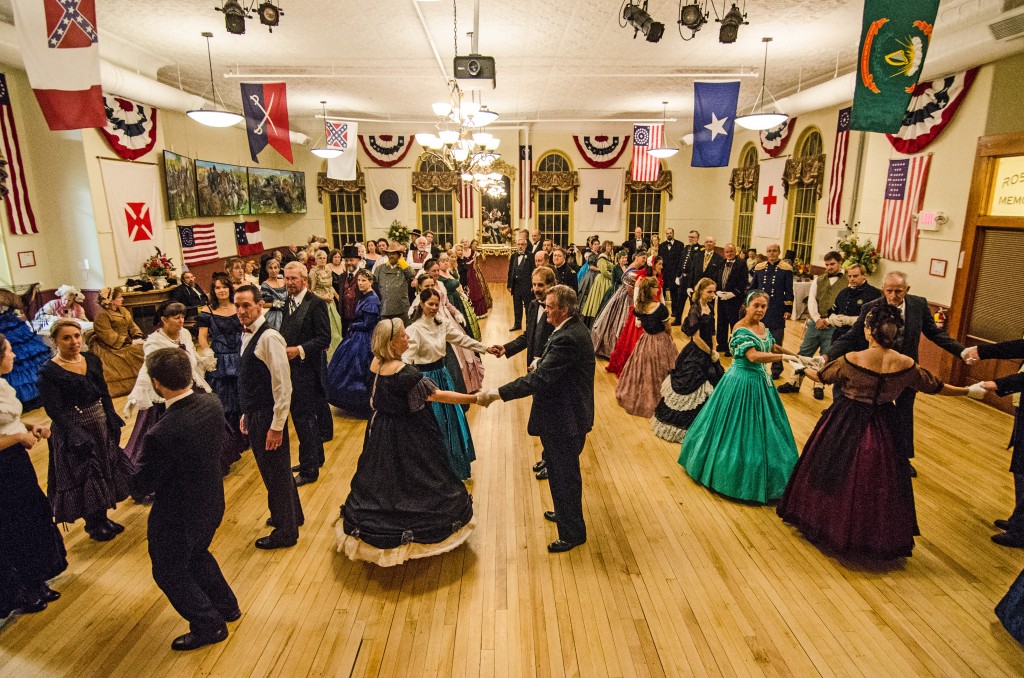
Dress was anything but casual at the Mayor’s Ball, where dozens of couples in period clothing danced the night away.
Joe Ewers, a spokesman for the string band, said that organizers of the event and St. Albans itself should be proud of the authentic detail adhered to in period clothing.
Retired Judge Ben Joseph took on the role of the judge who presided over re-enactments of the raiders’ trial in Montreal, while local attorneys Bill Cristman, Joshua Martin and assistant judge Bob Johnson played the attorneys who argued for the raiders, the U.S. government and British crown, respectively.
The judge in the first extradition hearing, Charles J. Coursol had decided he lacked jurisdiction over the case. The second judge, Judge Smith of Montreal, was willing to accept jurisdiction. He needed to determine if the raiders were criminals subject to extradition under a treaty between the U.S. and Great Britain, or if they were soldiers in the Confederate Army.
Attorneys for the U.S. government and the British crown argued the raiders had acted not as soldiers but as criminals. They had resided in Lower Canada for up to a year prior to the attack, were not acting under orders and had not even worn uniforms, the attorneys pointed out.
The defense argued the raiders were soldiers engaged in lawful acts of war. Moreover, the defense attorney suggested, the extradition treaty between the U.S. and Great Britain was no longer valid because the United States were no longer united.
Before rendering his verdict, Joseph polled the crowd of about 70 people, asking if the raiders were criminals or soldiers, all but a handful believed them to be criminals.
Both trial re-enactments drew large crowds to the county courthouse on Church Street, with more than 100 people attending the re-enactment of the first hearing.
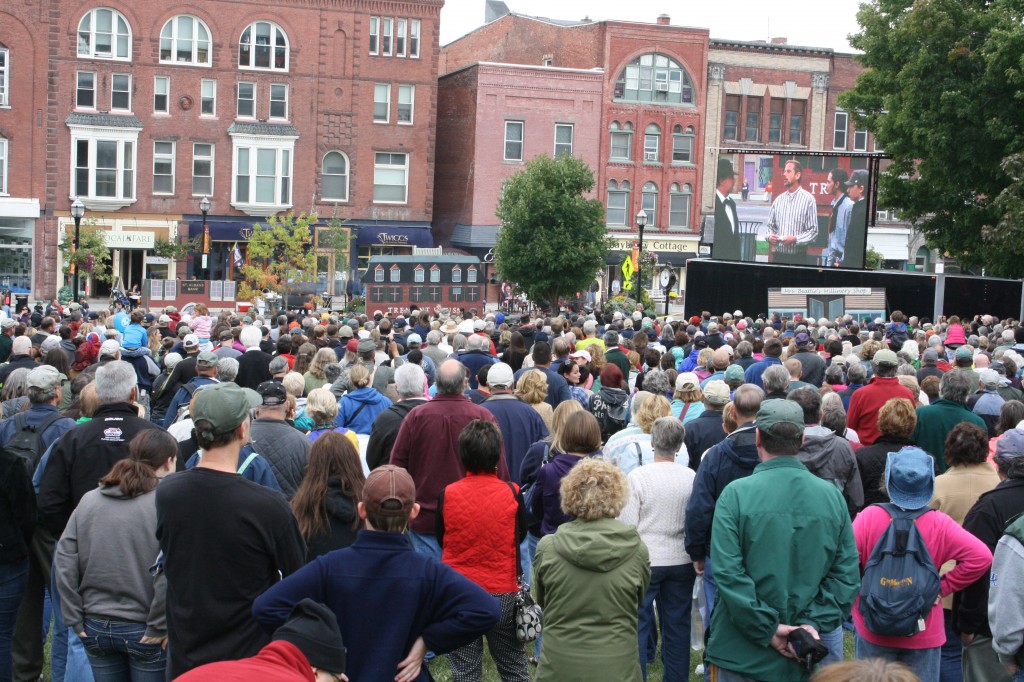
A crowd gathers to watch the St. Albans Raid reenactment.
On Friday and Saturday nights, Confederate soldiers attempted to rob local restaurants, but were blocked by Union soldiers, with gunfights breaking out in the street.
Despite the violence, Mayor Liz Gamache, who along with St. Albans Town Manager Carrie Johnson wore period clothing, described the weekend as “fabulous.”
“It just feels like this a celebration of a lot of years of hard work,” she said. That hard work included four years of careful planning by the raid organizing committee, as well as the efforts of St. Albans City to transform and revitalized downtown and assistance and support from St. Albans Town residents and officials.
Marty, the city’s director of business development, said downtown businesses did well this weekend. “From everyone I spoke to it was phenomenal,” he said.
Visitors came south from Canada and north from as far away as South Carolina, Kentucky, Virginia, and Florida. Organizers believe a gentleman from Ireland made the longest journey.
The city expects many of these visitors will return. “We planted a lot of seeds, I think,” said Manahan.
“The team that put this together did a great job,” he added.
—
By Michelle Monroe, St. Albans Messenger.


